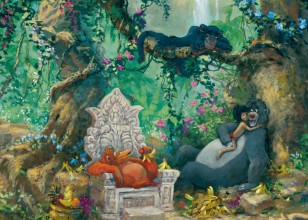Product Description
James Coleman is an American painter who has worked for Disney as a background artist on numerous animated features. In 1991, after twenty-two years working for Disney, James left to pursue the true passion in his life, fine art. However, James couldn't stay away from Disney for too long. Eventually he found himself mixing fine art with those all too familiar Disney Characters he had worked alongside for so many years.
ABOUT MICKEY MOUSE:
Throughout the earlier years, Mickey's design bore heavy resemblance to Oswald, save for the ears, nose, and tail. Ub Iwerks designed Mickey's body out of circles in order to make the character simple to animate. Disney employees John Hench and Marc Davis believed that this design was part of Mickey's success as it made him more dynamic and appealing to audiences.
Mickey's circular design is most noticeable in his ears. In animation in the 1940s, Mickey's ears were animated in a more realistic perspective. Later, they were drawn to always appear circular no matter which way Mickey was facing. This made Mickey easily recognizable to audiences and made his ears an unofficial personal trademark. The circular rule later created a dilemma for toy creators who had to recreate a three-dimensional Mickey.
In 1938, animator Fred Moore redesigned Mickey's body away from its circular design to a pear-shaped design. Colleague Ward Kimball praised Moore for being the first animator to break from Mickey's "rubber hose, round circle" design. Although Moore himself was nervous at first about changing Mickey, Walt Disney liked the new design and told Moore "that's the way I want Mickey to be drawn from now on."
Each of Mickey's hands has only three fingers and a thumb. Disney said that this was both an artistic and financial decision, explaining "Artistically five digits are too many for a mouse. His hand would look like a bunch of bananas. Financially, not having an extra finger in each of 45,000 drawings that make up a six and one-half minute short has saved the Studio millions." In the film The Opry House (1929), Mickey was first given white gloves as a way of contrasting his naturally black hands against his black body. The use of white gloves would prove to be an influential design for cartoon characters, particularly with later Disney characters, but also with non-Disney characters such as Bugs Bunny, Woody Woodpecker, Mighty Mouse, and Mario.
Mickey's eyes, as drawn in Plane Crazy and The Gallopin' Gaucho, were large and white with black outlines. In Steamboat Willie, the bottom portion of the black outlines was removed, although the upper edges still contrasted with his head. Mickey's eyes were later re-imagined as only consisting of the small black dots which were originally his pupils, while what were the upper edges of his eyes became a hairline. This is evident only when Mickey blinks. Fred Moore later redesigned the eyes to be small white eyes with pupils and gave his face a Caucasian skin tone instead of plain white. This new Mickey first appeared in 1938 on the cover of a party program, and in animation the following year with the release of The Pointer.[15] Mickey is sometimes given eyebrows as seen in The Simple Things (1953) and in the comic strip, although he does not have eyebrows in his most recent appearances.
Some of Mickey's early appearance, particularly the gloves, and facial characteristics, evolved from blackface caricatures used in minstrel shows.
Besides Mickey's gloves and shoes, he typically wears only a pair of shorts with two large buttons in the front. Before Mickey was seen regularly in color animation, Mickey's shorts were either red or a dull blue-green. With the advent of Mickey's color films, the shorts were always red. When Mickey is not wearing his red shorts, he is often still wearing red clothing such as a red bandmaster coat (The Band Concert, The Mickey Mouse Club), red overalls (Clock Cleaners, Boat Builders), a red cloak (Fantasia, Fun and Fancy Free), a red coat (Squatter's Rights, Mickey's Christmas Carol), or a red shirt (Mickey Down Under, The Simple Things)





